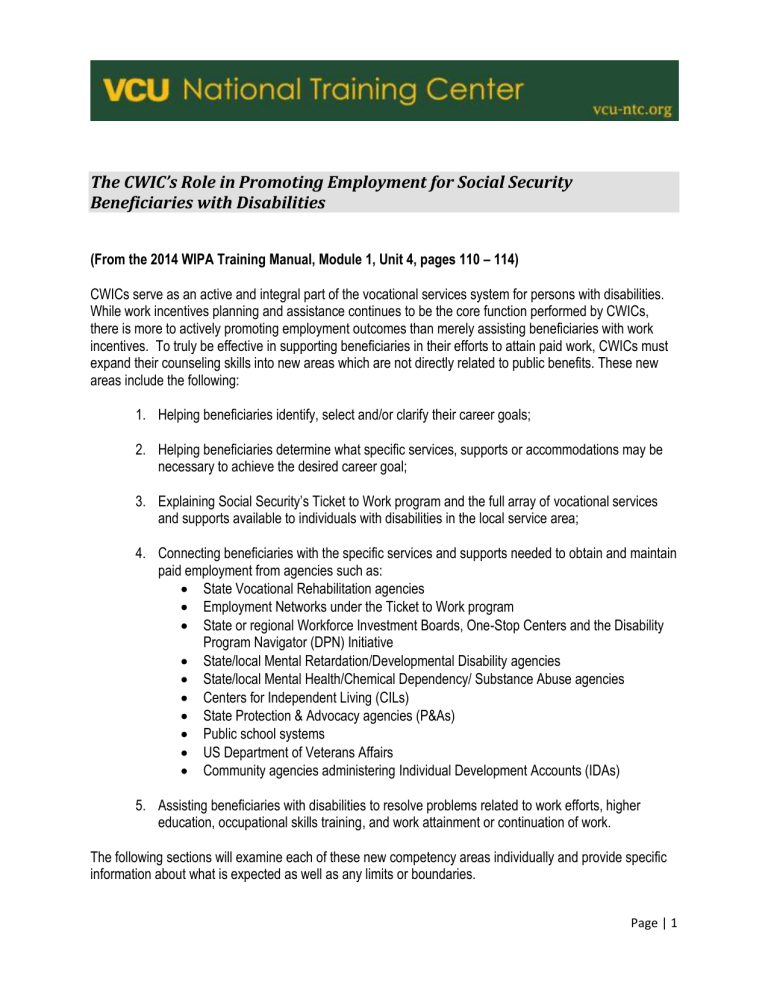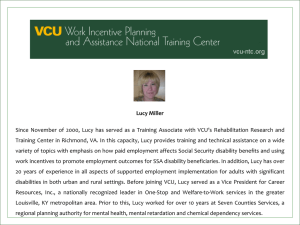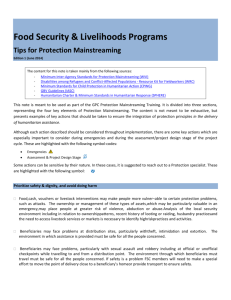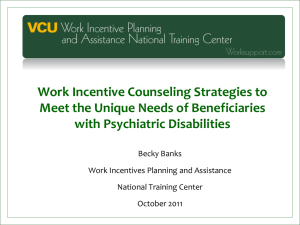The CWIC`s Role in Promoting Employment for Social Security

The CWIC’s Role in Promoting Employment for Social Security
Beneficiaries with Disabilities
(From the 2014 WIPA Training Manual, Module 1, Unit 4, pages 110 – 114)
CWICs serve as an active and integral part of the vocational services system for persons with disabilities.
While work incentives planning and assistance continues to be the core function performed by CWICs, there is more to actively promoting employment outcomes than merely assisting beneficiaries with work incentives. To truly be effective in supporting beneficiaries in their efforts to attain paid work, CWICs must expand their counseling skills into new areas which are not directly related to public benefits. These new areas include the following:
1. Helping beneficiaries identify, select and/or clarify their career goals;
2. Helping beneficiaries determine what specific services, supports or accommodations may be necessary to achieve the desired career goal;
3. Explaining Social Security’s Ticket to Work program and the full array of vocational services and supports available to individuals with disabilities in the local service area;
4. Connecting beneficiaries with the specific services and supports needed to obtain and maintain paid employment from agencies such as:
State Vocational Rehabilitation agencies
Employment Networks under the Ticket to Work program
State or regional Workforce Investment Boards, One-Stop Centers and the Disability
Program Navigator (DPN) Initiative
State/local Mental Retardation/Developmental Disability agencies
State/local Mental Health/Chemical Dependency/ Substance Abuse agencies
Centers for Independent Living (CILs)
State Protection & Advocacy agencies (P&As)
Public school systems
US Department of Veterans Affairs
Community agencies administering Individual Development Accounts (IDAs)
5. Assisting beneficiaries with disabilities to resolve problems related to work efforts, higher education, occupational skills training, and work attainment or continuation of work.
The following sections will examine each of these new competency areas individually and provide specific information about what is expected as well as any limits or boundaries.
Page | 1
Helping Beneficiaries Identify, Select and/or Clarify their Career Goals
Of the competency areas included in the CWIC position, this is the one that may cause the greatest challenge. Many CWICs do not come from a vocational counseling background, generally have little to no experience in vocational assessment and in most cases have not received any training in helping people determine a career goal. CWICs are not expected to provide formal career counseling or vocational assessment. This function is best performed by trained and experienced rehabilitation professionals either within the state Vocational Rehabilitation system or other private rehabilitation service provider agencies.
CWICs do need to know what type of career exploration and vocational assessment services are available within the community. They also must be prepared to directly refer beneficiaries to the various agencies based upon need. CWICs must take the time to conduct research and interview local agencies to gather this information.
While CWICs may not be expected to assume the lead role in career exploration, they still are expected to assist in several key ways. First, it is important for them to ask beneficiaries what their desired employment outcome and earnings goal is before they begin analyzing benefits or offering WIPA or advice.
Beneficiaries may not even be aware that there are services available to help them select an appropriate career goal and develop a plan for achieving this goal. A beneficiary who indicates that he/she has no clear employment objective is obviously in need of career counseling and needs to be referred for this service before any intensive work incentives advisement commences. While general information can be provided initially about the impact of earned income on Social Security benefits at this point, beneficiaries need to have identified a fairly specific occupational and earnings goal before customized WIPA services can be provided.
Secondly, it is often the case that beneficiaries establish employment objectives that are solely based upon fear of benefit reduction or termination and have nothing to do with interests, aptitudes, capabilities, or true earnings potential. CWICs can be invaluable in terms of helping individuals see the possibilities inherent in employment without unnecessary limits imposed by misunderstandings about what paid work might do to public benefits. A common example of beneficiaries choosing career goals based upon misinformation is seen with supported employment participants. These individuals tend to be persons with little or no work history who generally have significant disabilities and receive SSI. Many supported employment participants will identify a goal of part-time work in entry-level positions. In many cases, this employment goal is NOT selected because this is truly what they desire or need in terms of monthly income but because they believe (or their family members believe) that this is the ONLY level or type of employment that will not cause loss of benefits. In these cases, CWICs can show the beneficiary that even full-time work at prevailing wages is possible and will not cause termination from SSI or the loss of critical Medicaid coverage. Through effective work incentives counseling, they have the power to show beneficiaries the full range of employment possibilities, which can greatly influence the ultimate career goal!
Helping Beneficiaries Determine What Specific Services, Supports, or
Accommodations may be Necessary to Achieve the Desired Career Goal
CWICs often meet with beneficiaries who have a clear employment objective, but who also present some challenges or barriers in terms of achieving that outcome. In these cases, CWICs can offer a valuable service by helping the beneficiary think through the requirements of various jobs (or self-employment) and to identify the specific services or supports they will need to be successful in the chosen career. They should also work with the beneficiary to identify any needed accommodations, services or supports, since
Page | 2
these may indicate the work incentives the beneficiary should pursue. For example, an individual who will need a personal assistant at the workplace in order to perform the essential job functions may be able to purchase these services short term through a state VR agency, but may need to find a long term way to fund this service after VR case closure. In many cases, workplace personal assistance services would qualify as an Impairment Related Work Expense (IRWE) which Social Security can use to reduce countable income in both the SSI and Title II disability programs. In addition, beneficiaries could include workplace personal assistance services as an expense under a Plan for Achieving Self-Support (PASS). Having an understanding of what employment-related services and supports beneficiaries need will help CWICs be more effective in terms of promoting the desired employment outcome.
While some CWICs may feel uncertain about their ability to assist beneficiaries with determining the services and supports needed to achieve an occupational goal, technical support and advice in this area is readily available. In most local communities, Centers for Independent Living (CILs) and state AT Technical
Assistance Projects can offer training seminars to acquaint CWICs with the use of various assistive technologies, accommodation devices as well as rehabilitation services and supports. In addition, getting to know the full range of services available through the state VR agency will help them understand what is available to support an employment or self-employment objective. The CWIC does not need to be an expert in rehabilitation technology or job site accommodation but does need to have an awareness of what is possible as well as what is available in the local area. Finally, the VCU National Training Center has significant expertise on workplace services and supports or other job site accommodations. These professionals are available to answer any questions CWICs may have about a particular individual and his/her employment goal and can help them strategize on ways to leverage work incentives to pay for services and supports.
Explaining Social Security’s Ticket to Work Program and the Full Array of
Vocational Services and Supports Available to Individuals with Disabilities in
Local Communities
Many individuals with disabilities have difficulty navigating the complex world of services - particularly the myriad services available in the employment arena. First and foremost, CWICs need to be able to explain how the Ticket to Work program functions and how beneficiaries may use a Ticket to pay for the services and supports needed to achieve paid employment. The Ticket to Work is a work incentive available to beneficiaries of the Social Security disability programs and should be viewed as such by CWICs. This provision is complicated and is frequently misunderstood by beneficiaries. Any individual who is eligible for a Ticket to Work should have this provision explained in detail during the WIPA process.
Not only is it important to explain how the Ticket can be used to access services, but CWICs also must be able to provide information to beneficiaries about the numerous agencies which provide vocational services and supports. This would include Employment Networks operating within the Ticket to Work program, but also other federal, state, and local agencies which provide services outside of the Ticket to Work system.
When providing beneficiaries with information, it is simply not enough to hand out a list of agency names with contact information. The CWIC must review the provider options with the beneficiary and discuss which options make the most sense for the individual given his/her unique preferences and circumstances.
The various agencies represent an intimidating maze of services and supports. Each agency has its own eligibility criteria, program limitations, and referral processes. It is essential that CWICs assume responsibility for helping beneficiaries navigate their way through this maze of regulations and procedures to locate the programs that best meet the beneficiary’s needs.
Page | 3
Connecting Beneficiaries with the Specific Services and Supports Needed to
Obtain and Maintain Paid Employment
As previously stated, just providing beneficiaries with a list of agency names and phone numbers is not sufficient in terms of promoting employment outcomes. In many cases, beneficiaries will require assistance with being formally referred for services, or with making initial appointments. CWICs should be willing to make written referrals to agencies, call contact persons in other agencies to resolve questions, support the beneficiary with arranging the initial appointment, and be available to answer any questions posed by the provider agency. In some cases, the beneficiary is capable of making all arrangements independently and the CWIC simply conducts follow-up to make certain the contacts have been made and that services are progressing as planned.
CWICs use the Work Incentives Plan (WIP) to document the referrals which need to be made and the progress being made to access necessary services and supports. This plan will list all of the services identified as being necessary in order to achieve the employment goal and will describe who is responsible for making the referral and when it should occur. They will make regular contact with the beneficiary to make sure the beneficiary is accessing services and will help resolve problems or remove barriers as they may arise. The WIP will be reviewed and revised as needed. For more detailed information about the WIP and how this plan is used to structure benefits-related case management services, refer to Module 6.
Assisting Beneficiaries with Disabilities to Resolve Problems or Overcome
Barriers Related to Work Attainment or Continuation of Work
After initially receiving services from CWICs, many beneficiaries encounter problems connecting with the proper contact person or are denied services. When the plan for accessing the services necessary to attain employment goes awry, the CWIC needs to be available to assist with getting the plan back on track again. Depending on the reason for the problem, there may be a number of actions the CWIC can take. In some cases, the beneficiary may need to appeal a decision about being denied access to services. The
CWIC must be well-versed in the various processes agencies have for handling complaints or appeals and must be able to explain these to beneficiaries as well as offer support to complete these procedures. In most cases, the CWIC will not act as the advocate or representative of the beneficiary during an appeal but that may be necessary when no other options exist. Again, the CWIC is one partner on the employment support team and will work in collaboration with the other individuals on that team to support the beneficiary in working toward his/her employment goal. The Work Incentives Plan will guide the actions of the CWIC in these matters.
CWICs are expected to deliver the supports necessary over time to ensure that barriers to continued working posed by public benefits are reduced to the greatest extent possible. They should also use their knowledge to show individuals how work incentives can be applied to increase the financial benefit of employment or self-employment. When advising beneficiaries, CWICs should always ask themselves the following questions:
What is the next step along the road to employment for this person and what can I do to help him/her commit to taking that step?
Page | 4
What information do I need to provide to this beneficiary at this juncture in order to facilitate progression along the employment continuum?
Are there any barriers to employment this person faces related to public benefits and what can
I do to remove or minimize these barriers?
What specific services or supports can I provide at this point in time to help this beneficiary move forward down the road to employment or at least not lose ground?
What community partners do I need to coordinate with to enhance the effectiveness of my efforts to promote employment with this person?
Page | 5







